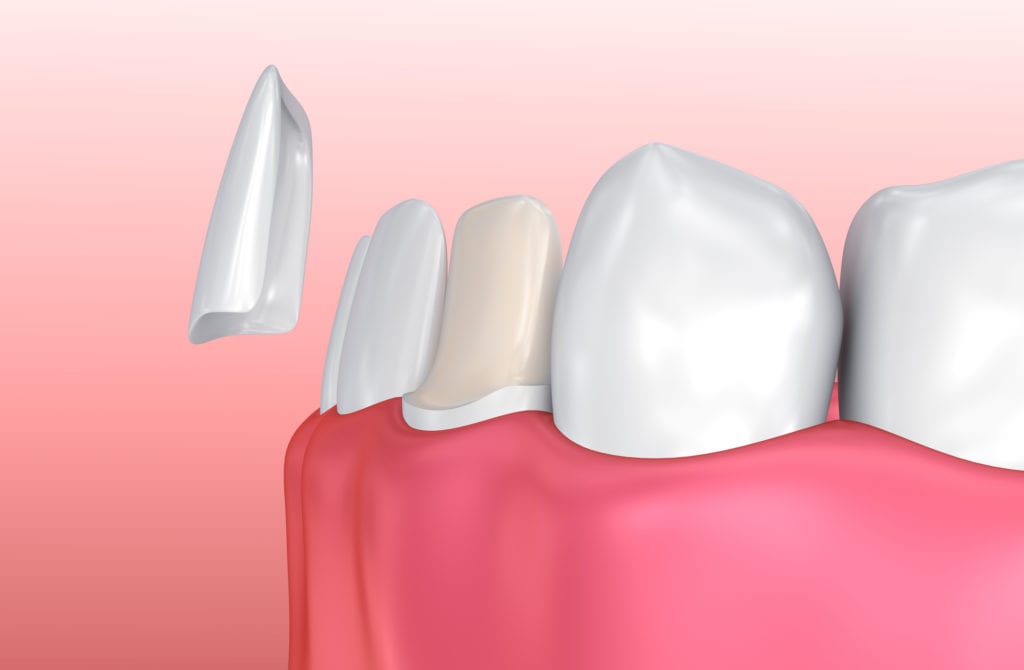Choosing Between Porcelain Veneers and Other Cosmetic Options
Wiki Article
Opening the Secrets of Veneers: Realities, Types, and Advantages for an Attractive Smile
Veneers offer a compelling service for those seeking to boost their smiles. These oral improvements can resolve numerous flaws, from discoloration to misalignment. With options like porcelain and composite, people can select based on their choices and needs. Nevertheless, comprehending the nuances of veneers, including application and treatment, is crucial. What elements should one consider before deciding? The answers might amaze those curious about this aesthetic dental option.
Understanding Veneers: What Are They?
Veneers are slim, customized shells created to cover the front surface area of teeth, boosting their look. Usually crafted from sturdy materials, these shells are tailored to fit each individual's teeth exactly. They offer numerous functions, consisting of remedying aesthetic blemishes such as staining, chips, or voids. The application process entails a dental expert preparing the teeth, frequently by getting rid of a percentage of enamel to ensure a snug fit. When prepared, the veneers are adhered to the teeth using a solid adhesive.Individuals typically pick veneers for their capacity to develop a natural-looking smile while giving a lasting remedy to oral blemishes. Unlike various other aesthetic dentistry choices, veneers require very little intrusive treatments, making them a preferred selection. The outcome is a better smile that can greatly increase an individual's self-confidence and self-worth. Overall, veneers provide an effective technique to attaining a much more harmonious and appealing oral appearance.
Kinds of Veneers: Porcelain vs. Composite
When considering cosmetic dental choices, 2 key types of veneers stand apart: porcelain and composite. Porcelain veneers are crafted from a durable ceramic product that mimics the natural appearance of teeth. They are recognized for their tarnish resistance and capacity to mirror light likewise to natural enamel, giving a visual appeal that numerous people need. The application procedure usually involves even more prep work of the tooth framework and might require numerous brows through to the dental practitioner.On the other hand, composite veneers are made from a tooth-colored resin that is straight related to the teeth. This type enables quicker application and can typically be finished in a solitary see. While they are cheaper than porcelain veneers, they may not use the very same long life or resistance to discoloration. Inevitably, the option between porcelain and composite veneers depends on individual preferences, spending plan, and particular oral demands.
The Benefits of Choosing Veneers
Picking veneers supplies various benefits that can significantly improve both the visual appeals and capability of a person's smile. Among the main benefits is their ability to deal with blemishes such as staining, spaces, and imbalance, leading to an extra uniform look. Veneers can additionally enhance the sturdiness of teeth, offering a protective layer that guards them from damage.Moreover, they require minimal tooth prep work compared to other oral procedures, protecting more of the all-natural tooth framework. This preservation adds to a healthier oral atmosphere while still attaining a spectacular smile.
Veneers are highly personalized, enabling people to select the form, size, and shade that ideal fits their preferences. In addition, they are stain-resistant, making it simpler to keep a intense and eye-catching smile gradually. In general, veneers provide an effective choice for those seeking both aesthetic improvement and long-term oral wellness advantages.
The Veneer Application Process
The veneer application process entails numerous crucial steps to guarantee suitable results. Initially, an appointment is performed to analyze the client's needs, adhered to by the prep work and shaping of the teeth. The veneers are adhered in area, with adjustments made for a perfect fit and appearance.Initial Examination Steps
A detailed preliminary appointment is vital for anybody taking into consideration veneers, as it establishes the structure for a successful treatment. During this conference, the dental professional examines the person's oral health and wellness, reviewing any type of existing problems that might impact the veneer application. This evaluation may consist of X-rays and an aesthetic evaluation to figure out the problem of the gums and teeth.The dental practitioner also engages the client in a thorough conversation concerning their aesthetic goals, choices, and assumptions. They might provide various veneer alternatives tailored to the person's details demands. Furthermore, the professional discusses the treatment, prospective threats, and aftercare demands, guaranteeing that the patient is educated and comfy prior to waging the treatment.
Preparation and Forming Teeth
After the initial appointment, the following phase entails the prep work and shaping of the teeth to accommodate the veneers. This essential action is carried out by the dental expert, who very carefully evaluates the tooth structure to figure out the amount of enamel that needs to be removed. Generally, a slim layer, generally around 0.5 millimeters, is slashed off to guarantee a correct suitable for the veneers. Accuracy is paramount during this process, as it influences both the general comfort and the aesthetic outcome. When the teeth are properly formed, perceptions are taken to create custom veneers that align completely with the client's dental profile. This precise prep work establishes the phase for a successful veneer application, enhancing both appearance and function.Bonding and Last Changes
Complying with the shaping and preparation of the teeth, the bonding process begins, marking an important phase in the veneer application. During this phase, a dental adhesive is used to the prepared tooth surface, guaranteeing a strong bond in between the tooth and the veneer. The dental expert meticulously positions the veneer, making changes to achieve the preferred alignment and appearances. When appropriately placed, a special light is made use of to cure the adhesive, solidifying the bond. After curing, the dentist carries out final adjustments, trimming any type of excess material and improving the veneer's shape to guarantee an all-natural look. This cautious focus to detail improves both function and looks, adding to an overall beautiful smile that is lasting and resilient.Caring for Your Veneers: Upkeep Tips
Caring for veneers is vital to preserve their look and durability. A regular daily cleaning regimen, conscious avoidance of staining foods, and routine dental exams are key elements of efficient upkeep. These methods aid ensure that veneers stay in peak condition and proceed to enhance one's smile.Daily Cleansing Routine
Regularly preserving veneers is vital for their durability and appearance. A correct daily cleaning routine can assist protect their sparkle and prevent damage. Dental practitioners suggest cleaning two times a day with a soft-bristled tooth brush and fluoride tooth paste, ensuring that all surface areas are cleaned carefully to stay clear of scraping the veneer surface area. Flossing everyday is also vital to remove food particles and plaque from in between teeth, where brushes may not get to. Furthermore, utilizing an antimicrobial mouth wash can assist keep dental health without hurting the veneers. It is a good idea to stay clear of unpleasant cleaners and tools that can scratch the veneer. By complying with these straightforward steps, people can maintain their veneers looking attractive while advertising general oral health.Preventing Discoloration Foods
Although veneers are created to enhance the look of teeth, their susceptibility to discoloring requires careful dietary choices. It is necessary for people with veneers to be mindful of specific foods and drinks that can result in staining. Dark-colored things such as coffee, red a glass of wine, and berry juices should be eaten in moderation, as they are understood to tarnish both natural teeth and veneers. In addition, acidic foods like citrus fruits can deteriorate the bonding representatives made use of in veneers, making them more vulnerable to staining. To keep an intense smile, it is suggested to rinse the mouth with water after eating staining foods and to practice routine dental hygiene. These thoughtful options add significantly to the longevity and appearances of veneers.
Routine Oral Exams

Maintaining the stability of veneers needs a dedication to regular oral check-ups, as these consultations play a vital function in ensuring their longevity and look. Throughout these visits, dental experts can evaluate the problem of the veneers, looking for any indications of wear, damage, or underlying dental concerns. Additionally, regular cleansings aid remove plaque and tartar that can build up around the veneers, advertising total oral health. Dentists can also offer tailored guidance on care strategies and products fit for veneer upkeep. By adhering to a routine of exams, people can deal with possible problems early, ensuring their smile continues to be lovely and lively. Eventually, routine oral check outs are a crucial part of veneer treatment.
Is Veneers the Right Option for You?
Making a decision whether veneers are the right alternative often hinges on specific aesthetic objectives and dental demands. For those seeking to deal with concerns such as discoloration, chips, or imbalance, veneers can provide a transformative solution. Candidates usually include people with healthy teeth yet want a boosted smile.
It is important to take into account aspects such as tooth enamel condition, the level of oral problems, and the determination to preserve veneers. Consulting with an oral specialist is necessary, as they can review oral wellness and identify if veneers are suitable
Furthermore, possible prospects should assess the long-term dedication, as veneers may require replacement every 10-15 years. Cost considerations additionally play a substantial role, as veneers can be a substantial financial investment. Eventually, the decision should be knowledgeable, balancing visual needs with sensible considerations for lasting outcomes.
Frequently Asked Questions
For How Long Do Veneers Generally Last Prior To Requiring Substitute?
Veneers normally last between 10 to 15 years before requiring substitute. Variables such as oral hygiene, way of life choices, and material top quality can affect their long life, making normal dental check-ups necessary for preserving their condition.Are Veneers Safe for People With Delicate Teeth?
Veneers can be risk-free for people with sensitive teeth, yet it typically relies on the extent of level of sensitivity and the dental expert's technique. Consulting an oral specialist before continuing is vital to guarantee suitable outcomes.Can Veneers Be Gotten Rid Of or Changed Conveniently?

Do Veneers Stain In Time, and Just How Can I Prevent It?
Veneers can stain gradually, especially from foods and beverages like coffee or red white wine. To avoid staining, preserving great dental hygiene, making use of a straw for beverages, and normal oral cleansings are suggested techniques.Porcelain Veneers Dentist
What Is the Price Range for Obtaining Veneers?
The expense of veneers normally varies from $500 to $2,500 per tooth, depending upon aspects such as product kind, dental professional experience, and place. Clients need to seek advice from dental experts for individualized quotes and funding options.As soon as the teeth are appropriately shaped, impacts are taken to produce customized veneers that align perfectly with the individual's oral profile. During this phase, an oral adhesive is applied to the ready tooth surface area, guaranteeing a strong bond between the veneer and the tooth. It is crucial to take into account factors such as tooth enamel problem, the level of dental concerns, and the determination to preserve veneers. Veneers can be safe for people with sensitive teeth, but it often depends on the extent of level of sensitivity and the dental practitioner's strategy. The cost of veneers typically varies from $500 to $2,500 per tooth, depending on aspects such as material kind, dentist experience, and area.
Report this wiki page